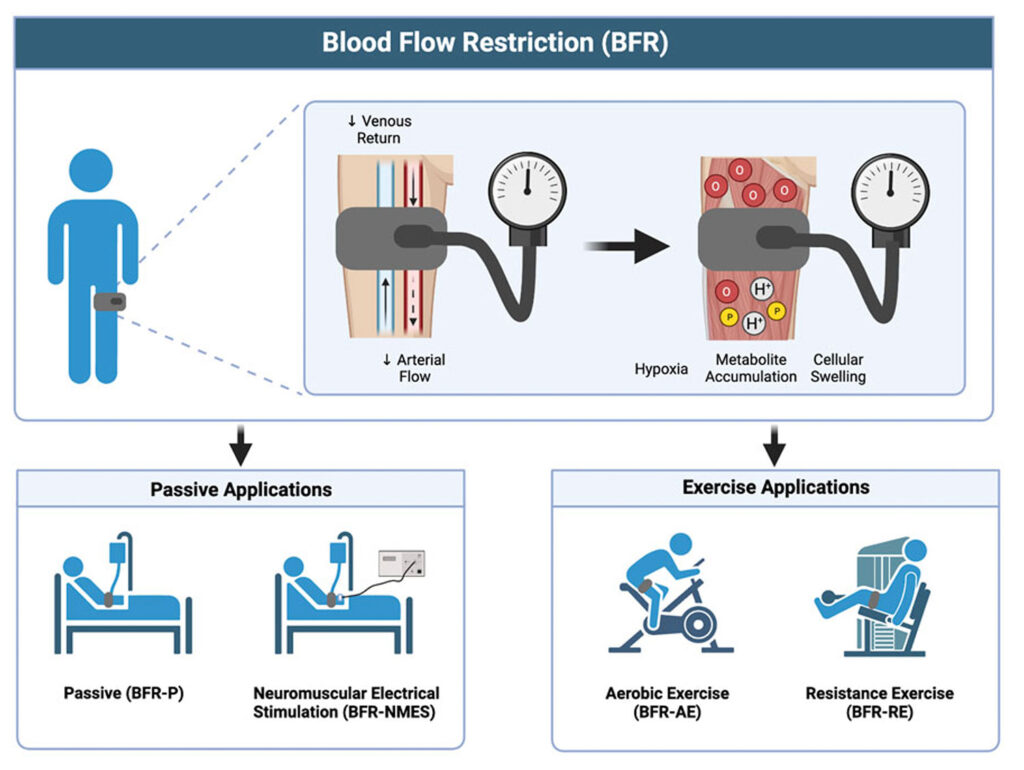Written by: Nathaniel Briscomb (Accredited Exercise Physiologist)
Blood flow restriction (BFR) training is a training method over 50 years old that involves partially restricting arterial inflow and fully restricting venous outflow in working muscles during exercise.
Dr. Yoshiako Sato coined the term “Kaatsu training” which literally means training with added pressure. He noticed a similar muscle soreness when in a deep kneel during prayer to when performing resistance training.
 Why is Blood flow restriction beneficial?
Why is Blood flow restriction beneficial?
The technique of BFR in muscles using a pneumatic tourniquet system involves applying external pressure with a tourniquet cuff to the upper and/or lower limbs’ proximal areas.
When the cuff is inflated, it gradually compresses the blood vessels beneath it, partially restricting arterial blood flow to areas below the cuff while more impeding venous outflow. This compression creates a hypoxic environment within the muscle tissue. This is thought to stimulate muscle protein synthesis, anabolic hormones released and muscle satellite signalling; all of which result in greater muscle strength and hypertrophy.
How is Blood flow restriction Applied in Practice?
BFR can be applied through both voluntary resistance exercises and aerobic exercises, and also passively without exercise.
New research has experimented with functional electrical stimulation. Allied health professionals that use BFR techniques require a special qualification, and this technique should only be applied under the supervision of Allied Health Practitioners such as Accredited Exercise Physiologists.
The Australian Institute of Sport (AIS) has developed a pre-screening questionnaire before the commencement of BFR training that can be found here (hyperlink)
 Safety Considerations for the use of Blood flow Restriction
Safety Considerations for the use of Blood flow Restriction
There is an inherent concern in adding pressure via less-precise methods than pneumatic torniquets with calibrated pressure. However, the totality of the research reveals minimal adverse advents.
The following safety considerations must be considered before applying BFR training: which can involve the risk of forming deep vein thrombosis (DVT).
Hypertension – People with high blood pressure are in hypercoagulative and potentially in a prothrombotic state (Yang et al., 2010).
Post-COVID-19 infection – Impaired blood clotting may occur due to inflamed blood vessels, excessive blood clotting or impaired blood flow (Sarkar et al., 2021).
Pregnancy – Shown to result in elevations of fibrinogen which increases the risk of DVT formation (Prisco et al., 2005).
Diabetes Mellitus – Patients with type 1 or type 2 are at increased risk of DVT due to systemic changes and endothelial dysfunction (Diabetes 2019)
Rheumatoid arthritis – Patients with rheumatoid arthritis are at increased risk of venous thrombosis, pulmonary embolism and DVT compared to the general populations (Li et al., 2021).
Chronic kidney disease – Elevated thrombogenic factors appear in greater proportions amongst those with kidney disease (Levey et al., 1998).
Post-surgery – The risk of DVT is increased 100-fold in the first 6 weeks following surgery (Bond et al., 2019) and pulmonary embolism is more significant in the first 12 weeks following surgery in middle aged women (Sweetland., 2009).
Anabolic steroid users – users have a higher risk of thrombotic complications, cardiomyopathy, stroke, pulmonary embolism, fatal and non-fatal arrythmias, and myocardial infarction (Sculthorphe et al., 2012).
Anabolic steroid users have side effects such as dyslipidemia, impaired blood vessel formation and cardiac hypertrophy (Seara et al., 2020).
The body of evidence relating to BFR training continues to grow, and the intention is to monitor research and clinical practice over time. The following parameters are an important summary for BFR training protocol:
The application of BFR should be limited to 20 minutes for the lower limb and 15 or less for the upper limb to allow time for reperfusion.
The width of the cuff is a major determinant of limb occlusion pressure.
Can be applied during voluntary resistance or aerobic exercise (also passively w/o exercise)
Complications with BFR must be considered and is on case-by-case basis.
A person is safe to proceed with BFR training if they have previously applied it and free of significant injury or illness within the last 6 months.

